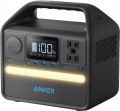Add to comparison |  |  |
|---|---|---|
| ANKER 521 PowerHouse | EcoFlow RIVER 2 | |
| Compare prices 2 | Compare prices 6 | |
| User reviews | ||
| TOP sellers | ||
2 USB A ports, 1 USB C port. Car cigarette lighter. LiFePo4 battery. Backlight. | 2 USB A ports, 1 USB C port. Car cigarette lighter, XT60 port. Surges up to 600 W are allowed. LFP (LiFePO4) – lithium iron phosphate battery. | |
| In box | charging station | charging station |
| Rated power | 200 W | 300 W |
| Peak power | 600 W | |
| Output waveform | sinusoid (PSW) | sinusoid (PSW) |
| UPS function | ||
Outputs | ||
| Sockets (230 V) | 1 | 1 |
| USB A | 2 5В/2.4А 12 W | 2 5В/2.4А 12 W |
| USB C | 1 3 A 60 W | 1 3 A 60 W |
| Car cigarette lighter | ||
Inputs (station charging) | ||
| From solar panels | ||
| Via USB-C | ||
| Input port XT60 | ||
| Add. ports | C13/14 (charging) | |
Battery and charging time | ||
| Battery type | LiFePO4 | LiFePO4 |
| Battery capacity | 256 W*h | 256 W*h |
| Charging cycles | 3000 | 3000 |
| Charging time (socket) ≈ | 236 min | 60 min |
| Charging time (solar panel) ≈ | 180 min | |
| Charging power (socket) | 65 W | 360 W |
| Charging power (solar panel) | 110 W | |
| Charging power (cigarette lighter) | 100 W | |
General | ||
| Smartphone synchronization | Bluetooth and WiFi | |
| PSU | external | built into the body |
| Display | ||
| Backlight | ||
| Carrying handle | ||
| Operating temperature | 0 °C ~ +40 °C | 0 °C ~ +45 °C |
| Dimensions | 216x212x144 mm | 142x245x214 mm |
| Weight | 3.7 kg | 3.5 kg |
| Warranty | 5 years | |
| Added to E-Catalog | november 2022 | november 2022 |